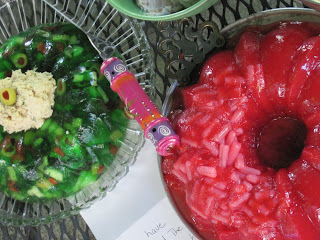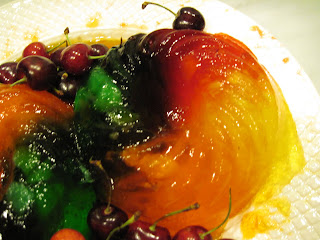I first encountered biscuits and gravy at Humps, one of the greasy "family dining" restaurants my mom loves to stop at on road trips to the Oregon coast. Oregon greasy spoons are like retro Mystery Spots. They transport the diner back to a time when jello on a lettuce leaf constituted salad and everything came with canned green bean casserole. Our ultimate greasy spoon experience, the one that lives on at family dinners and college plays (cough) and any time we cook coq au vin, was in Dexter, Oregon, not at the coast at all but on the way home from Mt. St. Helens.
When we pulled into Dexter we were starving and tired from a long hike--and a terrifyingly close call on what my mom calls dot-dot-dot roads. The one cafe in town had a giant hand-painted sign declaring, "Deadheads Welcome!" and a lot of cheerful hallooing coming from the bar. Thrilled by the surprisingly leftist local culture, my parents shooed us all into the cafe side of the building, where we were met by a tiny middle-aged lady with a big black beehive and cat-eye glasses. That should have been the first clue.
The second was that nothing on the menu was actually on order except for burgers, fried chicken and the evening special coq au vin, which our hostess whispered to us conspiratorially, "has wine in it, you know, but don't worry, it evaporates." She sighed and looked reflective for a moment. "I sure wish the cook would make something I can pronounce!"
The third was when the two gentlemen who arrived shortly after us ordered "hamboogers."
The fourth was that, despite the welcome sign, there were no hippies in evidence; we were decidedly out of our element.
And the fifth was when our lady of the elevated locks cocked her head toward the kitchen window and hollered, "Velma, heat up the oil!"
All of this is true. And the chicken came with a jello mold on leaf of iceberg lettuce, canned wax beans, and some suspiciously hard biscuits.
But at Humps, although there was no adorable hostess in a fifties pants suit--or any deadheads, there was biscuits and gravy. Lumpy, fatty sausage gravy that congealed quickly on top of rich Crisco biscuits. I had the worst stomachache after that meal, and decided I was allergic to biscuits and gravy, which was probably a good call for my heart but a bad one for my mouth, because my word, biscuits and gravy can be good.
Take tonight's dinner, for example. With homemade buttermilk biscuits and a vegetarian portobello mushroom gravy, this country dish takes a slightly sophisticated turn while staying true to its comfort food roots. I'm not going to lie--this isn't health food (though the gravy recipe is from Eating Well magazine and would be healthy served over mashed potatoes or some lean meat), but it is delicious and perfect for cold nights when its pouring (Portland) or snowing (east coast) and you want something warm and simple to eat with a salad. Or a jello mold on lettuce, your choice.
The biscuit recipe is taken from the FoodDay section of the Oregonian, given to me by my father-in-law, and it's one of the best biscuit recipes I've tried (and perfect biscuits are a minor passion of mine). I think the trick is rolling the biscuits in melted butter, so that both top and bottom get a little crunchy while the inside turns into soft, flaky layers. Be sure not to overwork the dough, and to press down lightly on the flour mixture just after integrating the butter. This creates flaky layers during the baking process.
Note: get the gravy simmering before assembling the biscuits. Biscuits are best eaten fresh out of the oven, so you want to wait until 20 minutes or so before the gravy is done to get started on them. The gravy can be made in advance; unbaked biscuits can be chilled in the fridge for up to an hour before baking.
BUTTERMILK BISCUITS AND PORTOBELLO GRAVY
For the biscuits:
- Preheat the oven to 450 degrees F and melt 4 T butter in an 8-in square baking dish. (I just stick the dish in the oven as it heats up.) Set pan with melted butter aside.
- In a large bowl, mix 2 C flour with 2 tsp baking powder, 1/4 tsp baking soda, and 1/2 tsp salt.
- Cut 4 T of cold, unsalted butter into small chunks and toss into the flour. Using a pastry cutter, two butter knives, or your fingers, work the butter into the flour until the mixture resembles coarse cornmeal. Gently press your palm against the mixture once or twice.
- Make a well in the center of the flour mixture and pour in 3/4 C buttermilk. (I found I needed 1-2 more T of milk to make the dough cohere.) Using your hands, mix the dough just until it forms into a ball and leaves the sides of the bowl.
- Dump the dough onto the counter and knead no more than 10-12 gentle times before rolling the dough out no less than 1-inch thick. Using a biscuit cutter or a drinking glass, cut the dough into 2-3 inch biscuits. Gently gather up the scraps to make more biscuits until all of the dough is used up. You should get between 6-9 biscuits per batch.
- Roll each biscuit in the melted butter so that each side is buttered, and nestle all of the biscuits into the pan (you want them to touch). Bake for 12-15 minutes until risen and golden brown.
For the portobello gravy:
- Finely chop one small onion, two cloves of garlic and 2 medium-sized portobello mushroom caps.
- Heat 1 T of olive oil in a pan and gently cook the onion and garlic until soft and translucent, roughly 5 minutes.
- Add the mushrooms and saute, stirring occasionally, until they release their juices, around 10 minutes.
- Add 2 1/4 C vegetable or chicken stock to the pan, along with 3 T of tamari or low sodium soy sauce and a couple pinches of dried thyme and dried sage. Let simmer for 10 minutes.
- In a separate bowl, make a slurry of 4 T water and 2 T cornstarch. Mix until well combined.
- Add slurry to the gravy and simmer for another 10 minutes, stirring frequently.
- Pepper and salt to taste.
- Split open a hot biscuit and add a couple ladlefuls of mushroom gravy. We ate ours with a raw broccoli and apple salad, but any fresh green veggies will cut the richness of the dish and add some vitamins.















































